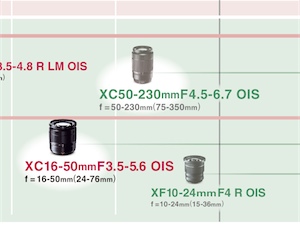Fujifilm now offering new X-E1 and X-Pro1 firmware with focus peaking; adds lens to roadmap
posted Tuesday, July 23, 2013 at 3:23 PM EDT

About a month ago, Fujifilm announced new firmware for the Fujifilm X-Pro1 and X-E1. Today those free firmware updates became available, bringing faster AF speeds and the much hyped "focus peaking" highlight feature to Fuji's X-mount cameras. Simultaneously, Fujifilm has announced a new lens as part of its XC line of lenses aimed at the more affordable Fujifilm X-M1.
The Fujifilm lens roadmap has been updated to include the XC50-230mm F4.5-6.7 OIS lens, which is due by the end of the year. Unfortunately, not much information is available, apart from the fact that it is a 75-350mm equivalent. It, alongside the XC16-50mm lens, make up the XC series of lenses, which are described as:
"'compact and casual' lenses and are perfectly suited to the mid-range X-M1 compact system camera. They feature all-glass elements and are lightweight and portable."
The X-Pro now has firmware version 3.00 and the X-E1, version 2.00. Despite the differences in versioning, the description of the new firmwares are identical:
1.Improvement of AF speed on most existing XF lenses.
The updated algorithm will enable AF speed to become faster with the following XF lenses:
XF14mmF2.8 R
XF18mmF2 R
XF35mmF1.4 R
XF60mmF2.4 R Macro
XF18-55mmF2.8-4 R LM OIS.
<Note>
To enjoy this improvement, firmware upgrade of those XF lenses are also required.
Lens Firmware
2."Focus Peak Highlight" function for manual focusing is added.
The function, which features on FUJIFILM X100S and X20, is added and assists accurate and sensitive manual focusing by enhancing the outline of your subject in high contrast.
3.Improvement of the method to switch magnification during manual focusing.
Press the "Command dial" to activate image magnification during manual focusing and then turning the dial in either right or left direction will enable you to alternate the magnification of 3 times and 10 times.
4.Improvement of focus accuracy in various scenes.
The focus detection algorithm is improved to provide more accurate focus for low contrast subjects and scenes containing horizontal stripes.
